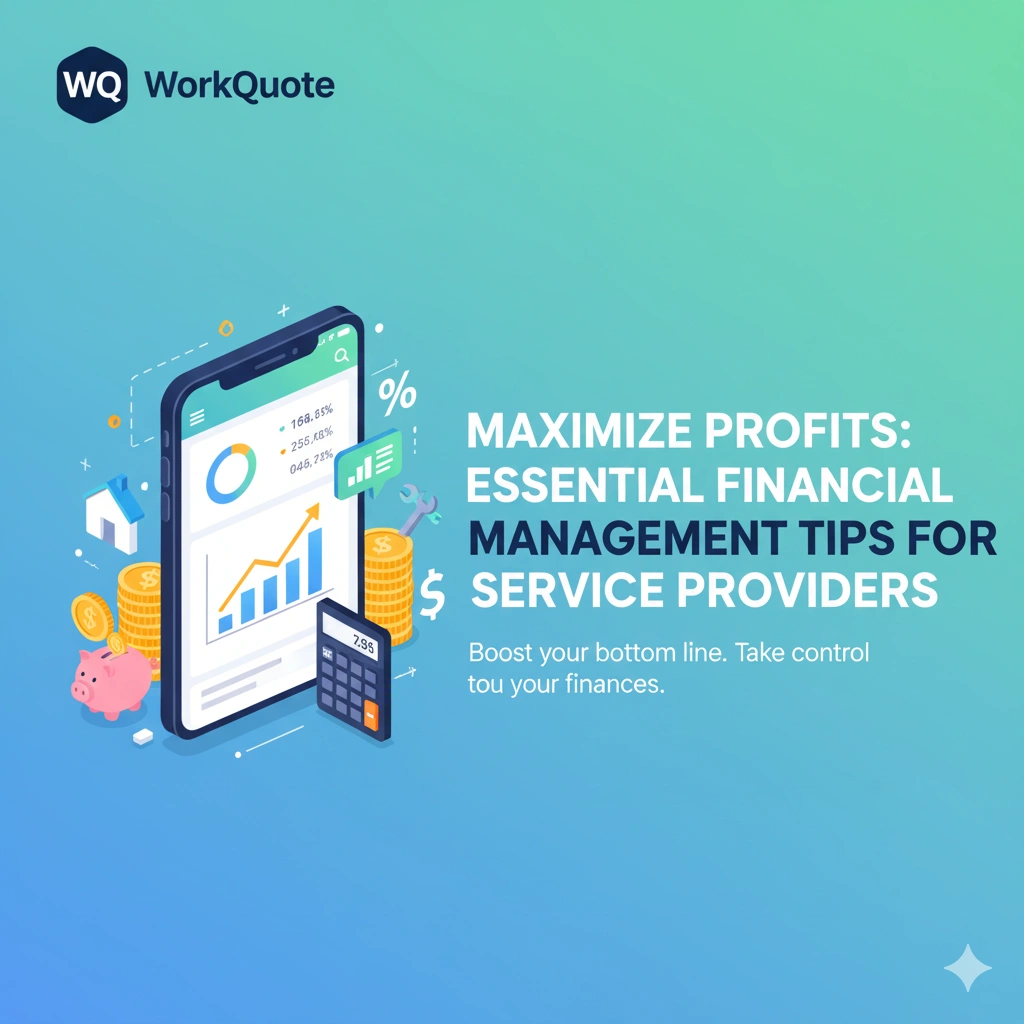
Discover proven financial management strategies that service providers can implement to boost profitability, streamline operations, and build sustainable business growth. Learn how to optimize pricing, control costs, and leverage technology for better financial outcomes.
Understanding Your True Profit Margins
Many service providers struggle with accurately calculating their profit margins, often overlooking hidden costs that eat into their bottom line. Understanding your true profitability requires a comprehensive view of all expenses, from direct labor costs to overhead expenses like insurance, equipment maintenance, and administrative time.
Start by categorizing your expenses into direct costs (materials, labor directly tied to jobs) and indirect costs (rent, utilities, marketing, software subscriptions). This separation helps you understand which jobs are truly profitable and which might be costing you money despite generating revenue.
Calculate your profit margin for each service type you offer. You might discover that certain services generate higher margins than others, allowing you to focus your marketing efforts on the most profitable offerings. This analysis also reveals opportunities to adjust pricing or eliminate low-margin services that don't contribute meaningfully to your overall profitability.
Strategic Pricing for Maximum Profitability
Pricing your services correctly is fundamental to maximizing profits. Many service providers undervalue their expertise and time, leading to unsustainable business models. Develop a pricing strategy that accounts for your skill level, market demand, and the value you provide to clients.
Consider implementing value-based pricing rather than purely hourly rates. This approach focuses on the outcomes and benefits you deliver to clients rather than just the time spent. For specialized services, clients are often willing to pay premium rates for expertise and guaranteed results.
Research your local market thoroughly to understand competitive pricing while identifying opportunities to differentiate yourself. Premium pricing becomes viable when you can demonstrate superior quality, faster turnaround times, or specialized expertise that competitors lack.
Build pricing flexibility into your service offerings through tiered packages. Offer basic, standard, and premium options that cater to different client budgets while encouraging upgrades to higher-margin services. This strategy increases average transaction values and improves overall profitability.
Streamlining Operations to Reduce Costs
Operational efficiency directly impacts your profit margins. Identify bottlenecks and inefficiencies in your current processes that consume time and resources without adding value. Common areas for improvement include scheduling, client communication, invoicing, and project management.
Standardize your service delivery processes to reduce time spent on each job while maintaining quality. Create checklists, templates, and standard operating procedures that help you work more efficiently and reduce the likelihood of costly mistakes or rework.
Evaluate your tool and equipment investments regularly. While quality tools often require higher upfront costs, they typically reduce long-term expenses through improved efficiency, reduced maintenance needs, and better results that justify premium pricing.
Consider the total cost of ownership for all business investments, including software subscriptions, vehicle maintenance, and equipment purchases. Sometimes spending more initially leads to significant long-term savings and improved profitability.
Leveraging Technology for Financial Management
Modern service businesses benefit significantly from technology that automates financial processes and provides real-time insights into business performance. Integrated business management platforms can streamline everything from initial estimates to final invoicing, reducing administrative overhead and improving cash flow.
Automated invoicing systems ensure timely billing and reduce the administrative burden of manual invoice creation. Set up recurring invoices for regular clients and implement automated payment reminders to improve collection rates and reduce outstanding receivables.
Expense tracking becomes much more manageable with digital tools that categorize expenses automatically and integrate with your accounting systems. This automation reduces the time spent on bookkeeping while providing better visibility into spending patterns and cost control opportunities.
Business analytics tools help you identify trends in your financial performance, seasonal fluctuations, and opportunities for growth. Regular analysis of key performance indicators like average job value, client acquisition costs, and profit margins per service type guides strategic decision-making.
Optimizing Cash Flow Management
Healthy cash flow is essential for service business profitability. Even profitable businesses can struggle if cash flow timing doesn't align with operational needs. Implement strategies to accelerate receivables and manage payables effectively.
Require deposits or partial payments upfront for larger projects. This practice improves cash flow while reducing the risk of non-payment. Structure payment schedules to align with project milestones, ensuring steady cash inflow throughout longer engagements.
Offer multiple payment options to make it easier for clients to pay quickly. Accept credit cards, digital payments, and bank transfers to remove barriers to prompt payment. Consider offering small discounts for early payment to incentivize faster collection.
Monitor your accounts receivable closely and follow up on overdue invoices promptly. Implement a systematic approach to collections that maintains professional relationships while ensuring timely payment. Late payments can significantly impact your cash flow and overall profitability.
Building Recurring Revenue Streams
Recurring revenue provides stability and predictability that improves long-term profitability. Identify opportunities within your service offerings to create ongoing relationships with clients rather than one-time transactions.
Maintenance contracts, regular service agreements, and subscription-based offerings can provide steady income streams that require less marketing investment than constantly acquiring new clients. These arrangements often command premium pricing due to their convenience and reliability.
Develop service packages that encourage long-term commitments from clients. Annual contracts or seasonal service agreements can provide better rates for clients while guaranteeing revenue for your business. This approach improves cash flow predictability and reduces the cost of client acquisition.
Focus on client retention through exceptional service delivery and regular communication. Retaining existing clients costs significantly less than acquiring new ones and often leads to referrals that further reduce marketing expenses.
Managing Seasonal Fluctuations
Many service businesses experience seasonal variations in demand that can impact profitability. Develop strategies to smooth out these fluctuations and maintain steady income throughout the year.
Diversify your service offerings to include options that perform well during different seasons. For example, landscaping businesses might offer snow removal services during winter months, while HVAC companies can focus on maintenance contracts during slower periods.
Build cash reserves during peak seasons to support operations during slower periods. This financial cushion prevents the need for expensive short-term financing and allows you to maintain service quality and staff during temporary downturns.
Use slower periods for business development activities like marketing, training, equipment maintenance, and process improvements. This approach ensures you're prepared for busy seasons while making productive use of available time.
Controlling Direct and Indirect Costs
Cost control is equally important as revenue generation for maximizing profits. Regularly review all business expenses to identify opportunities for reduction without compromising service quality or customer satisfaction.
Negotiate better rates with suppliers and service providers. Long-term relationships often provide leverage for improved pricing on materials, insurance, and other recurring expenses. Consider bulk purchasing for frequently used items to achieve volume discounts.
Monitor fuel and vehicle costs closely, especially for mobile service businesses. Route optimization, vehicle maintenance, and fuel-efficient driving practices can significantly reduce transportation expenses. Consider the total cost of vehicle ownership when making fleet decisions.
Evaluate insurance coverage annually to ensure you're getting competitive rates while maintaining adequate protection. Work with brokers who understand service businesses to find policies that provide necessary coverage without excessive premiums.
Investment in Growth and Efficiency
Strategic investments in your business can drive long-term profitability improvements. Focus on investments that either increase revenue potential or reduce ongoing operational costs.
Professional development and certification programs can justify premium pricing and open new market opportunities. Specialized skills and credentials differentiate your services from competitors and support higher profit margins.
Quality equipment and tools often pay for themselves through improved efficiency and better results. Calculate the return on investment for major purchases by considering time savings, improved quality, and reduced maintenance costs.
Marketing investments should be measured against client acquisition costs and lifetime customer value. Focus on marketing channels that provide the best return on investment while building long-term brand recognition and client relationships.
Performance Monitoring and Continuous Improvement
Regular performance monitoring ensures your financial management strategies remain effective and identifies opportunities for improvement. Establish key performance indicators that align with your profitability goals.
Track metrics like profit margin per job, average transaction value, client acquisition cost, and customer lifetime value. These indicators provide insights into business health and guide strategic decisions about pricing, marketing, and operational improvements.
Conduct monthly financial reviews to assess performance against goals and identify trends that require attention. This regular analysis helps you respond quickly to changes in market conditions or business performance.
Benchmark your performance against industry standards when possible. Understanding how your business compares to similar service providers can reveal opportunities for improvement and validate successful strategies.
Consider working with financial advisors or business consultants who specialize in service businesses. External expertise can provide valuable insights and help you implement best practices that drive improved profitability.
Building Long-Term Financial Stability
Sustainable profitability requires a long-term perspective that balances immediate financial needs with future growth opportunities. Develop financial strategies that support both current operations and future expansion.
Maintain adequate cash reserves to handle unexpected expenses or temporary revenue declines. Financial stability provides the flexibility to take advantage of growth opportunities and weather economic uncertainties.
Plan for business growth by understanding the financial requirements of expansion. Whether adding staff, expanding service areas, or investing in new equipment, growth requires careful financial planning to maintain profitability.
Consider the tax implications of your business decisions and work with qualified tax professionals to optimize your tax strategy. Proper tax planning can significantly impact your net profitability and cash flow.
Implementing these financial management strategies requires commitment and consistent execution, but the results can transform your service business profitability. Focus on the areas that offer the greatest impact for your specific situation, and gradually implement additional strategies as your business grows and evolves. Remember that financial management is an ongoing process that requires regular attention and adjustment to maintain optimal results.

